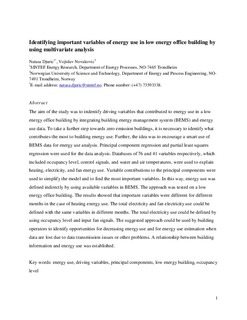| dc.contributor.author | Djuric, Natasa | |
| dc.contributor.author | Novakovic, Vojislav | |
| dc.date.accessioned | 2019-01-21T13:52:08Z | |
| dc.date.available | 2019-01-21T13:52:08Z | |
| dc.date.created | 2012-01-17T22:06:05Z | |
| dc.date.issued | 2012 | |
| dc.identifier.citation | Energy and Buildings. 2012, 45 91-98. | nb_NO |
| dc.identifier.issn | 0378-7788 | |
| dc.identifier.uri | http://hdl.handle.net/11250/2581592 | |
| dc.description.abstract | The aim of the study was to identify driving variables of energy use in a low energy office building by integrating building energy management system (BEMS) and energy use data. To take a further step towards zero emission buildings, it is necessary to identify what contributes the most to building energy use. Further, the idea was to encourage a smart use of BEMS data for energy use analysis. Multivariable analysis was used for the data analysis. Databases of 76 and 41 variables respectively, which included occupancy level, control signals, and water and air temperatures, were used to explain heating, electricity, and fan energy use. The results showed that important variables were different for different months in the case of heating energy use. The total electricity and fan electricity use could be defined with the same variables in different months. The total electricity use could be defined by using occupancy level and input fan signals. The suggested approach could be used by building operators to identify opportunities for decreasing energy use and for energy use estimation when data are lost due to data transmission issues or other problems. A relationship between building information and energy use was established. | nb_NO |
| dc.language.iso | eng | nb_NO |
| dc.publisher | Elsevier | nb_NO |
| dc.rights | Attribution-NonCommercial-NoDerivatives 4.0 Internasjonal | * |
| dc.rights.uri | http://creativecommons.org/licenses/by-nc-nd/4.0/deed.no | * |
| dc.title | Identifying important variables of energy use in low energy office building by using multivariate analysis | nb_NO |
| dc.type | Journal article | nb_NO |
| dc.type | Peer reviewed | nb_NO |
| dc.description.version | acceptedVersion | nb_NO |
| dc.source.pagenumber | 91-98 | nb_NO |
| dc.source.volume | 45 | nb_NO |
| dc.source.journal | Energy and Buildings | nb_NO |
| dc.identifier.doi | 10.1016/j.enbuild.2011.10.031 | |
| dc.identifier.cristin | 888458 | |
| dc.description.localcode | © 2011. This is the authors’ accepted and refereed manuscript to the article. This manuscript version is made available under the CC-BY-NC-ND 4.0 license http://creativecommons.org/licenses/by-nc-nd/4.0/ | nb_NO |
| cristin.unitcode | 194,64,25,0 | |
| cristin.unitname | Institutt for energi- og prosessteknikk | |
| cristin.ispublished | true | |
| cristin.fulltext | postprint | |
| cristin.qualitycode | 2 | |

